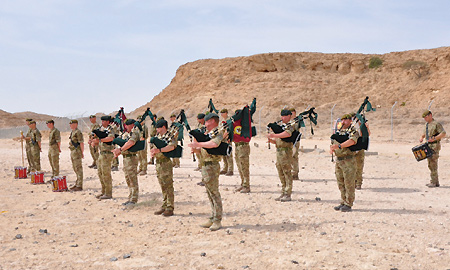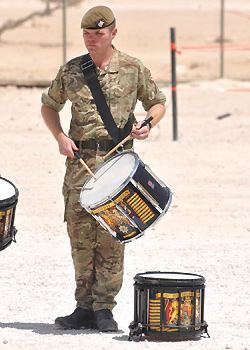|
OPERATING AS A SECTION COMMANDER IN THE OMANI DESERT
by Lance Sergeant G W Chambers
Irish Guards
|

The Drums and Pipes on St Patrick’s Day
|
On 24th February 2015, No 4 Company left Mons Barracks for RAF Brize Norton bound for Oman. The Battalion’s last exercise there was in 2001 as armoured infantry so for many, including myself, there was a sense of a fresh challenge and something to look forward to. It would certainly make a nice change having recently completed a cold range package in Lydd as well as an exercise on Aldershot Training Area in preparation.
Having completed a tour of Iraq and Afghanistan I imagined the Oman climate and terrain to be of a similar nature, being hard to manoeuvre over with stunning scenery and this was to be very much the case. Upon arrival we found ourselves based in our new home at Rabkut with a few Americans waiting to go home having recently completed three months training.
The exercise was split into four parts, the first being platoon blank firing training and navigation, followed by a live firing package, a final training exercise, followed by some well-deserved R&R. The blank firing training gave us a chance to acclimatise, get used to our surroundings and more importantly for a Section Commander, to see how each member of the section would cope in this challenging environment. The time was used well, conducting basic but essential skills such as locating the enemy and patrol formations as well as FIBUA training. We trained to operate both during the day and at night and this phase proved a solid foundation on which to build throughout the rest of the exercise.
It was not until the live firing package, in particular the section and platoon attacks, that the harsh reality of operating in the desert began to take its toll. With temperatures as high as 43 degrees, with each man carrying four litres of water, full scales of ammunition, radios and full PPE, movement across this tough terrain was slow and energy sapping. The live firing package was also a challenge but was very enjoyable. Conducting a live company attack with mortars (provided by the Coldstream Guards) and snipers was an experience which many will not have again.
Navigation was another key challenge as a commander. The training area was full of conical-shaped high features which seemed to appear out of the rock and sand, all of which looked very similar. A lesson learned early was that navigating using these features was almost impossible; one needed to trust the compass bearing.
After the live firing phase, the company enjoyed a couple of days of downtime in camp as well as a full St Patrick’s Day parade alongside the Omani soldiers with whom we were working. It was a nice occasion, with shamrock presented by the Defence Attaché and music provided by the Drums and Pipes.
The final exercise began in the early hours of the morning of 18th March with a recce screen deploying the night before. For this phase we used Tactical Electronic Simulation (TES) equipment. This invaluable kit, which uses lasers to notify a soldier if he has been shot as well as providing a platform on which to construct an after-action review, was extremely useful and added a level of realism to the whole experience. I also found it most useful when we took casualties. This forced better teamwork between me and another section commander on the clearance of the position. The ability to review each attack was also a great help since we could see where mistakes had been made and where we needed to improve next time.
The exercise finished on 23rd March with a company dawn attack which was observed by the Commander Royal Army of Oman. In conclusion, operating in the desert as a section commander is a very challenging task with the main focus being the need to constantly check the members of the section, making sure they are hydrated, carrying the right kit, and being able to carry out whatever task is presented. I thoroughly enjoyed the exercise, a good opportunity to get to know my section well as we lived closely alongside each other for five weeks. I would recommend this exercise to any section commander. It provides excellent training during the platoon phase, with opportunities to work at section level, developing collective skills. It also provides excellent conditions for Guardsmen and Lance Corporals to improve on map reading and operating ‘one up’.
We all enjoyed our time in Oman and certainly will return to the Battalion with a better understanding of soldiering for future operations, wherever they may be.

One of LSgt Chambers’ LMG gunners provides fire support |
 The author providing some musical entertainment
The author providing some musical entertainment
for our Omani friends |
|
|



